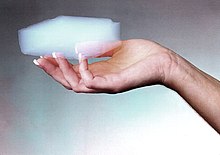
aerogel: gel comprised of a microporous solid in which the dispersed phase is a gas. (See Gold Book entry for note.) [1]
Aerogels are a class of synthetic porous ultralight material derived from a gel, in which the liquid component for the gel has been replaced with a gas, without significant collapse of the gel structure.[2] The result is a solid with extremely low density[3] and extremely low thermal conductivity. Aerogels can be made from a variety of chemical compounds.[4] Silica aerogels feel like fragile styrofoam to the touch, while some polymer-based aerogels feel like rigid foams.
Aerogels are produced by extracting the liquid component of a gel through supercritical drying or freeze-drying. This allows the liquid to be slowly dried off without causing the solid matrix in the gel to collapse from capillary action, as would happen with conventional evaporation. The first aerogels were produced from silica gels. Kistler's later work involved aerogels based on alumina, chromia, and tin dioxide. Carbon aerogels were first developed in the late 1980s.[5]
- ^ "aerogel". Gold Book (3rd ed.). IUPAC. 2019 [2014]. doi:10.1351/goldbook.A00173. ISBN 978-0-9678550-9-7. Archived from the original on 30 November 2012. Retrieved 1 April 2024.
- ^ Alemán, J. V.; Chadwick, A. V.; He, J.; Hess, M.; Horie, K.; Jones, R. G.; Kratochvíl, P.; Meisel, I.; Mita, I.; Moad, G.; Penczek, S.; Stepto, R. F. T. (2007). "Definitions of terms relating to the structure and processing of sols, gels, networks, and inorganic-organic hybrid materials (IUPAC Recommendations 2007)". Pure and Applied Chemistry. 79 (10): 1801–1829. doi:10.1351/pac200779101801.
- ^ "Guinness Records Names JPL's Aerogel World's Lightest Solid". NASA. Jet Propulsion Laboratory. 7 May 2002. Archived from the original on 25 May 2009. Retrieved 25 May 2009.
- ^ Aegerter, M.A.; Leventis, N.; Koebel, M. M., eds. (2011). Aerogels Handbook. Springer publishing. doi:10.1007/978-1-4419-7589-8. ISBN 978-1-4419-7477-8.
- ^ Pekala, R. W. (1989). "Organic aerogels from the polycondensation of resorcinol with formaldehyde". Journal of Materials Science. 24 (9): 3221–3227. Bibcode:1989JMatS..24.3221P. doi:10.1007/BF01139044. ISSN 0022-2461. S2CID 91183262.